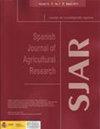蔬菜豌豆(Pisum sativum L.)多样性:与作物改良相关的可利用优良种质资源分析
IF 0.8
4区 农林科学
Q3 AGRICULTURE, MULTIDISCIPLINARY
引用次数: 1
摘要
研究目的:确定豌豆育种材料的多样性,目的是对一组携带新的/经济变异的潜在亲本进行分类,这些亲本可用于未来的豌豆品种。研究领域:印度蔬菜研究所,瓦拉纳西。材料和方法:利用17个农业形态性状和52个SSR标记对45份豌豆材料的表型和分子多样性进行了分析。主要结果:所有性状均表现出显著的遗传变异。基因型在荚/株、10荚重和产量/株等性状上分别表现出6.7倍、2.7倍和12倍的变异。52个SSR标记中有22个具有多态性。共检测到90个等位基因变异,平均每个基因座有2.7个等位突变。标记AA135(0.79和0.81)和PSMPSAD51(0.7和0.74)的PIC和D值最高,而AB40(0.19和0.2)最低。两个主要成分PC1和PC2分别解释了46.96%和23.96%的总变异。基于农业形态特征的聚类将45个个体分为三个大型聚类,而基于SSR标记的聚类将这些材料分为四组。研究重点:基于它们的独特性,我们鉴定了一组携带各种经济性状基因的基因型(VRPD-2、VRPD-3、PC-531、“Kashi Nandini”、“Kash Udai”、“Kashi Mukti”、”Arkel“、VRPE-101、”Azad Pea-3“、EC865944、VRPM-901和VRP-500)。本文的研究结果将对通过选择性渗入育种改良豌豆的育种家非常有用。本文章由计算机程序翻译,如有差异,请以英文原文为准。
Vegetable peas (Pisum sativum L.) diversity: An analysis of available elite germplasm resources with relevance to crop improvement
Aim of study: To determine the amount of diversity in pea breeding materials with the objective to classify a set of potential parents carrying novel/economic variations that could be used in future breed pea varieties.
Area of study: ICAR–Indian Institute of Vegetable Research, Varanasi.
Material and methods: A total of 45 pea accessions were analysed for phenotypic and molecular diversity using 17 agro-morphological traits and 52 SSR markers.
Main results: All traits under investigation showed considerable genetic variation. The genotypes exhibited 6.7, 2.7 and 12-fold variation for traits viz., pods/plant, 10-pod weight and yield/plant, respectively. Among 52 SSR markers, 22 were found to be polymorphic. A total of 90 allelic variants were detected, with an average of 2.7 alleles/locus. PIC and D-values for markers AA135 (0.79 and 0.81) and PSMPSAD51 (0.7 and 0.74) were the highest, while AB40 (0.19 and 0.2) had the lowest. Two principal components PC1 and PC2 explained 46.96 and 23.96% of total variation, respectively. The clustering based on agro-morphological traits differentiated 45 individuals into three mega clusters, while SSR markers-based clustering classified these accessions into four groups.
Research highlights: Based on their uniqueness, we identified a set of genotypes (VRPD-2, VRPD-3, PC-531, ‘Kashi Nandini’, ‘Kashi Udai’, ‘Kashi Mukti’, ‘Arkel’, VRPE-101, ‘Azad Pea-3’, EC865944, VRPM-901 and VRP-500) harbouring genes for various economic traits. The findings presented here will be extremely useful to breeders who are working on improvement of peas through selective introgression breeding.
求助全文
通过发布文献求助,成功后即可免费获取论文全文。
去求助
来源期刊

Spanish Journal of Agricultural Research
农林科学-农业综合
CiteScore
2.00
自引率
0.00%
发文量
60
审稿时长
6 months
期刊介绍:
The Spanish Journal of Agricultural Research (SJAR) is a quarterly international journal that accepts research articles, reviews and short communications of content related to agriculture. Research articles and short communications must report original work not previously published in any language and not under consideration for publication elsewhere.
The main aim of SJAR is to publish papers that report research findings on the following topics: agricultural economics; agricultural engineering; agricultural environment and ecology; animal breeding, genetics and reproduction; animal health and welfare; animal production; plant breeding, genetics and genetic resources; plant physiology; plant production (field and horticultural crops); plant protection; soil science; and water management.
 求助内容:
求助内容: 应助结果提醒方式:
应助结果提醒方式:


